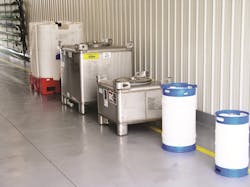Container management systems for herbicides are not new to the industry, but in recent years have gained popularity with both vegetation managers and applicators. While there are multiple systems on the market, all of them tend to provide the same baseline services: a supply of herbicides in returnable, refillable containers; specified tank mixes with herbicide concentrates composed of various products; and the ability to track the container movement from the herbicide repacker to its delivery destination.
Accountability and worker safety are common motivators for adopting a container management system. Knowing where your herbicides are and when and where they were applied helps manage these valuable resources. Having the herbicide mix in one container helps to ensure the desired mix is applied and there aren’t variations between multiple batches.
There are also operational efficiencies gained by not having to devote time to triple-rinsing and disposing of traditional herbicide containers.
Worker safety is paramount in all operations. Mixing and handling herbicides should always be done with care and according to label directions, but mistakes can and do happen. When they happen, the results can impact the workers involved and the company as a whole. Using a closed-loop container management system is a way to reduce the risk of a spill or mixing error.
Procurement managers favor the tracking component of the system, as it provides documentation of herbicide container delivery and use on a specified system, thereby accounting for all products. Another procurement benefit is reduced inventory. The containers are generally delivered within a few days, reducing the need to keep weeks’ or months’ worth of product on hand. If a system or applicator only uses a few different mixes, the number of items in inventory can be greatly reduced because there’s no need to keep individual products in stock, only the ready-made tank mixes. The tracking also helps mitigate any issues that may arise surrounding when and what was applied to a given piece of land.
While the benefits of a container management system are rather straightforward, implementing the change is not always easy. Applicators may not think the system is right for them or that it will be hard to transition spray crews to a new way of mixing. Utilities and system managers may view a container management system as an additional job responsibility or as a change that isn’t justified because they aren’t having issues with their current system.
It’s easier to overcome those hurdles with support. The Utility Arborist Association includes the use of a closed-loop system as a best management practice in its publication, “Field Guide to Closed Chain of Custody for Herbicides in the Utility Vegetation Management Industry.” Also, talking with peers who have already taken the steps to implement such a program is a great way to learn how to overcome startup challenges and better understand the true return on investment received from these systems. Take the opportunity to learn from their experiences and see if a closed-loop system might be a fit for your program.
Sponsored by:
™®Trademarks of Dow AgroSciences, DuPont or Pioneer, and their affiliated companies or their respective owners.
©2019 Corteva Agriscience

